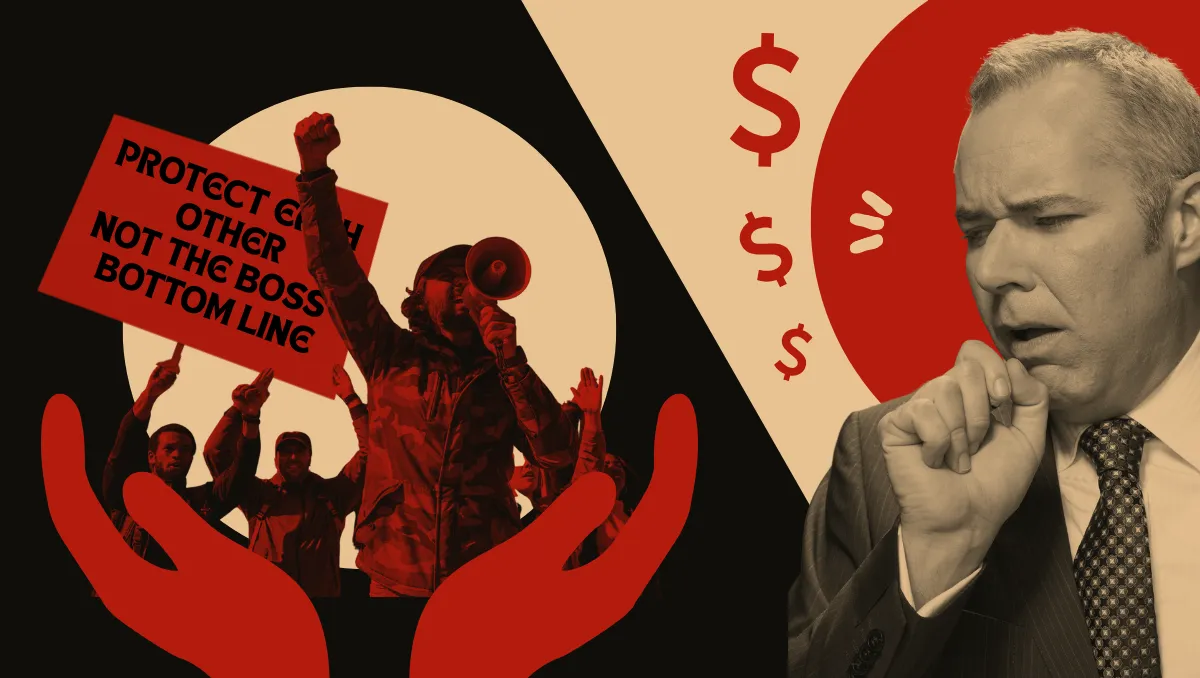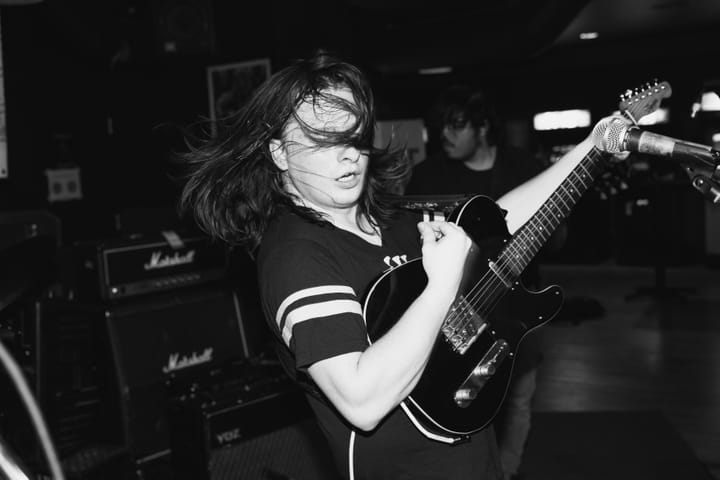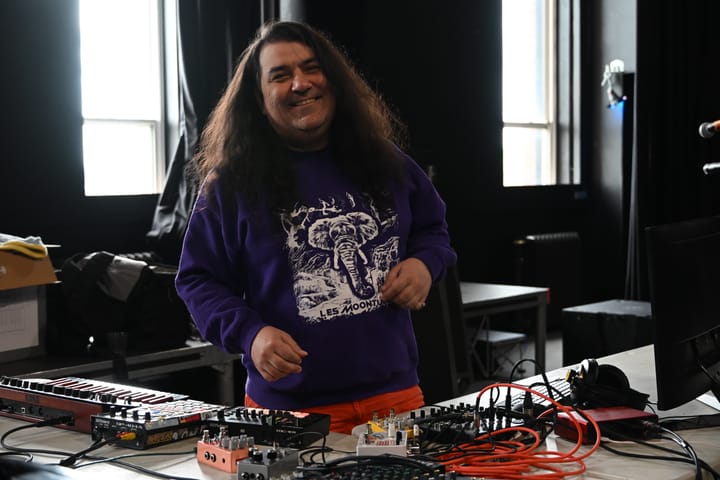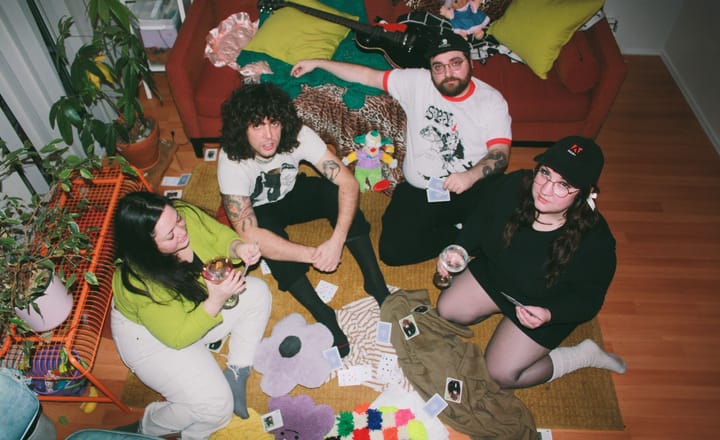
COVID is (STILL) a Working Class Issue
“I’ve been singing every day since I was about five years old, but in June [2024], I hit a period of time where I went nine months without singing at all.” Sky Cameron holds back tears as they recall the weight of the grief they’ve felt as a musician now dealing with long COVID. The Toronto based soprano vocalist and classical musician, originally from Nova Scotia, had an acute COVID infection in 2021 which persisted with long term symptoms they are still navigating. “I’m not grieving it because of my chronic illnesses. I’m grieving because of the industry itself and its inability to even have conversations about access and access needs.” Cameron is one of the 3.5 million Canadians who have had long COVID since 2020, one of the many disabled by the disease who have virtually vanished from public life without any collective grief or acknowledgement whatsoever. Seemingly for the majority of the population, COVID-19 is something in the past, something we’ve left behind and moved on from, and that is abundantly apparent in the music industry.
Stepping into a live music venue in 2025, there are no signs that COVID-19 remains a persistent threat. There are very few shows that require or encourage wearing masks, proof of vaccination is a distant memory, and if the token bottle of hand sanitizer at a venue hasn’t completely disappeared, the thick layer of dry, rubbery gel on the nozzle suggests that it’s seen better days. Many of us have quickly learned to accept that our friends and loved ones have lingering, persistent coughs. I notice it mostly in the lull between songs in a live set. People seem genuinely puzzled that they’re now sick all the time, and not just getting sick more frequently, but being hit harder, too. Maybe you’ve started hearing others speaking about the pandemic in the past tense, or started speaking about it that way yourself. Maybe a few artists you were following prior to 2020 haven’t been playing shows since the reopening, but their silence is deafened by the many new projects that can take their place. Over five years into this pandemic, its erasure from public consciousness has allowed the music industry to sidestep necessary structural changes, leaving working-class musicians and live music workers more precarious than ever.
The music industry is deeply tied to the night time economy, which not only fuels its venues and events but also serves as a primary employer for musicians and other arts workers. When the pandemic hit, the abrupt shut down quickly revealed just how precarious workers in those positions are. This work is largely in person, pays minimum wage, happens in crowded spaces with poor ventilation, rarely offers paid sick days or leave, much less any kind of health insurance or job security. These pre-existing inequities are not unique to this industry, but ones that have been exacerbated by the ongoing pandemic.
Before COVID-19, Chelsea McBride was a renowned jazz saxophonist and composer based in Toronto and Vancouver, playing in and leading a multitude of projects including her big band, Chelsea McBride’s Socialist Night School. But once the Canada Emergency Response Benefit (CERB) support program halted and the live music industry started to reopen, McBride found that there were fewer well paid gigs than there had been pre-pandemic, and that the market really wasn’t in a position to even reach the steady income she had been getting with CERB. “The gigs that came back didn’t pay anymore,” she recalls. “There was no bump from inflation because everyone had just taken this huge economic hit, and the conditions were worse.” There were even fewer opportunities to take on other work elsewhere within the industry, like grant writing, which she continues to do on the side.
Fewer well-paying gigs meant McBride had to take more work just to make ends meet, increasing her risk of contracting COVID, which happened in early 2022. She subsequently developed symptoms of long COVID, which she’s been navigating ever since. “Every time I’ve had COVID, it’s been reasonably fine through the course of the illness and then symptoms just never go away. So it keeps stacking,” she explains.
Long COVID, also known as post-acute sequelae of SARS-CoV-2 infection (PASC), is a condition where people continue to experience symptoms weeks or months after the initial acute COVID-19 infection. As of June 2023, three and a half million people, nearly 10% of all Canadians, have, or have had long COVID. There are likely far more. These symptoms can include fatigue, brain fog, shortness of breath, chest pain, neurological or cardiovascular issues, and they may range from mild to debilitating and can affect anyone, regardless of how severe their initial illness was. Those are the most commonly occurring symptoms, but there are many others which vary from person to person, which complicates diagnosing, treating, or educating the greater public.
McBride didn’t get her voice back until a month after recovering from her initial COVID infection, but she continued to get winded all the time. Prior to COVID, she would run marathons, and as a woodwind player, her lung capacity is of major importance. She also previously had an autoimmune condition and migraines, which have worsened with long COVID. “In disability circles we talk a lot about spoons and how many spoons you have for the day and I use that framework a lot with my friends, or ‘spell slots,'” she explains. Now her life has become a constant calculus budgeting the capacity she has to perform, travel, and even just to be able to show up for her partners and loved ones. With slowed work, and changing levels of energy, McBride made the decision to pursue her master’s of music at William Paterson University in Wayne, NJ, and is now pursuing doctoral studies at the University of Miami’s Frost School of Music, with academia offering a more consistent and reliable source of income, as well as health insurance she didn’t have working primarily as a musician.
McBride’s case is not unusual. To write this story I put out a call to speak with musicians who have been affected by long COVID. There were far too many respondents to interview, but of the group who reached out, the majority of musicians and music workers navigating long COVID were first infected after 2022, amidst the lifting of many pandemic restrictions and preventions worldwide, and in spite of the fact that the first round of vaccinations and boosters had been released. None of the musicians I spoke with for this piece work in the industry full time, reflecting the lived reality of many musicians and music workers, especially since the pandemic was first acknowledged as such.
In an economic survey of Canadian artists and content creators conducted in 2021, the Canadian government found that the majority of the respondents were self employed, and not working full time in their creative occupation. Only about 41% of respondents reported working full time in their creative field. In their Hear and Now report, co-published in 2025 with consulting firm Nordicity, the Canadian Live Music Association estimated the average salary for a full-time employee in the Canadian live music industry is “slightly more” than $31,000 a year. Statistics Canada’s census data from 2016 indicated the median income of all musicians at the time was just $17,900. Respectively, both figures are just at, or below, the country’s poverty line.
The numbers paint a clear picture of just how precarious Canadian musicians and music workers are in the country’s labour market. They also show how vulnerable this population is when it comes to the continued risks of COVID. “If you’re holding a concert without any COVID precautions, people are becoming disabled at your shows. People who are already disabled are becoming more disabled. I find it profoundly negligent to be holding concerts without any COVID precautions in 2025,” says Courtney Garvin.
Since 2020, the now Irvine, California based Garvin’s life as a touring musician in the Courtneys and Gum Country has been upended by long COVID— experiencing fatigue, migraines and shortness of breath, severely limiting her mobility and ability to be creative. In 2023, Garvin experienced a lowering of her baseline from a reaction to a medication, later developing debilitating nerve pain in her arms that has meant letting go of playing the guitar entirely. “I spend most of my day just lying in bed unable to tolerate any stimulus or distract myself with anything. It’s just me and my mind, and that’s been super hard to explain to people,” she says. On Instagram, Garvin documents her experience, sharing the loss of the calluses not only on her fingers from no longer being able to play the guitar, but on her feet as well, from not being able to take many steps before becoming completely exhausted.
Living with this chronic illness, Garvin says it’s been very disheartening to see the music industry and society at large move on. Especially when the necessary changes needed to take place to make events safer from the spread of COVID are within reach. Some interventions, such as improved indoor air ventilation, have been with us since the previous pandemic. Vancouver’s Orpheum Theatre, built in 1927, has often been referred to as “pandemic proof” thanks to its displacement ventilation system, which works by shifting stale air toward the ceiling from vents in the floor. Interventions like these become all the more important when 20%-40% of all COVID transmission is still asymptomatic, which means people can be carrying and transmitting COVID to others without knowing it.
“I’d like to see a minimum standard set for all concerts that includes upgraded ventilation via HEPA and UV in venues, masks made available and encouraged, and a virtual option of a livestream. We can look to sports for inspiration on how great livestreaming could be,” she explains. “I think these things are achievable today for shows of every size, even DIY venues.” For Garvin, the issue isn’t a lack of solutions, it’s the way that the end of the pandemic has been normalized and accepted. The tools to make live music safer already exist; what’s missing is the collective commitment to value all members of the music community. As Garvin’s experience shows, the people most affected by COVID aren’t just an abstract vulnerable group of the young and old, they’re active participants in our cultural life, whose needs are being ignored in favor of convenience and profit.
The mainstream media and Canadian public health units have constructed an idea of who is “vulnerable” to the short-and long-term effects of COVID-19, often alongside logics of acceptance or justification for why it’s okay for those people to get sick. While it’s true that most of the current COVID deaths are limited to the very young and old, media coverage often highlights these figures or similar comorbidities, like autoimmune conditions, to make it seem as though only a limited set of the population is exposed to COVID-19 related risks, while the rest of us are expected to show up to work until that’s just no longer possible.
Kayli Jamieson, a musician and researcher with Simon Fraser University’s Faculty of Health Sciences, is currently studying how long COVID has been depicted in news media and public health statements. She has also had long COVID for over three years. “I’m looking at the discursive choices that news media and these public health statements use in the construction of a ‘back to normal,’” she explains about her master’s thesis work. While the research is still underway, Jamieson says there are already a number of themes that are emerging, such as the widespread use of the phrase “post-pandemic,” or acknowledging COVID but framing newer variants as milder with insufficient evidence. Even vaccination is often only encouraged for individuals who may be “high risk.”
But that very construction of who is “high risk” or “vulnerable” in these circumstances shifts dramatically when you take the social determinants of health into account. A study published by the Public Health Agency of Canada on the social inequalities in COVID-19 deaths found that the impacts of COVID-19 were unequally distributed across the country, and when comparing the population in groups based on income, mortality rates were nearly twice as high (1.9 times) for the lowest income population group as in the highest income group. Another Statistics Canada study also found a higher burden of COVID-19 cases, hospitalizations, and deaths among people belonging to racialized populations. Because income inequality in Canada is closely intertwined with systemic racism, these racialized health disparities are not separate from class— they are part of how class is constructed and experienced. Given that many musicians and music industry workers fall into lower income brackets, these findings underscore that COVID-19 is unequivocally a class issue, and one that working-class artists cannot afford to ignore.
The gulf between the lived reality of the rich and poor under COVID couldn’t be any clearer than it is in the music industry. While most of the industry has publicly “moved on,” many A-list artists and their teams still quietly take extensive precautions to protect their tours and revenue streams. Despite her shows earning a reputation for becoming superspreader events among her loyal fans, Taylor Swift enforces a strict “bubble” that includes her dancers and management, limiting where they can go and who they can interact with while on the road. Other artists have followed suit, leading to a decline in popular meet-and-greet opportunities. Legacy acts like rockers Triumph continue to hold meet-and-greets in 2025 but have explicit COVID protections for the band and attending fans. For their high-stakes farewell world tour, KISS made use of a Canadian UV technology developed by a Vancouver-based firm to mitigate infection. Adele’s Las Vegas residency went ahead in 2022 with £400,000 (approx $733,638 CAD) worth of air purification and ventilation equipment to ensure the singer’s treasured voice would go unharmed.
Part of the reason why these major artists don’t talk about COVID outright is because of liability. Many media outlets like Pitchfork, Billboard, and Exclaim! have stopped reporting on COVID show cancellations almost entirely, giving the impression that it isn’t a reality or concern for major touring artists anymore. These editorial choices are informed by the fact that major artists are less inclined to announce tour cancellations or postponements resulting from contracting COVID-19 while on the road, because protection against the contagious disease is being written out of touring insurance policies. Previously, policies offered buy-backs for communicable disease losses with an extra premium, but because of the amount of money these insurance companies had to pay out simultaneously when the industry quickly shuttered in March 2020 (upwards of $44 billion dollars, with the cancellation of the 2020 edition of Coachella estimated close to $200 million alone), insurers are now purposefully limiting their exposure to future losses due to the pandemic, leaving all of the risk to touring artists.
Strategies like those observed in the insurance industry are characteristic of the neoliberal response to the pandemic: offloading the responsibility of mitigating exposure onto individuals. We can see how this manifests at all ends of the class spectrum, leaving already precarious workers at a serious disadvantage to get the protections they need. What this abdication of responsibility fosters is a culture of denialism, where major artists neither address the immense protections they take to ensure their health, nor the instances where they do get sick because it bears immense financial burden. Getting sick also becomes a personal failing and carries with it stigma, as it becomes a measure of how much or how little someone did to avoid it.
Just as insurance companies are dropping pandemic protections to insulate themselves from financial risk, federal, provincial, and municipal governments in Canada have ended vital supports like CERB, distribution of free COVID-19 test kits, widespread population testing, wastewater testing, vaccination programs, and mask requirements. One of President Trump’s first acts in office was an order that took down long COVID data from government websites in a string of actions that targeted federal resources and research on the long COVID crisis. As we see with everything from the climate crisis to Palestine, denialism isn’t just an absence of knowledge or an unwillingness to engage with facts, it functions as an active ideological position that shapes political reality by maintaining power and deflecting responsibility. Sociologist and gay rights advocate Gary Kinsman calls this the “social organization of forgetting.” How might things be different if you still had access to PCR COVID testing? What if you and your local public health agency had verifiable proof you were exposed to COVID at your job? Who would bear the weight of that responsibility then?
These choices ultimately function as a form of abandonment. The withdrawal of care, support, or visibility is itself a way of denying people’s humanity, crisis, or claim to life. It’s important to understand how these choices function within the music industry and public health because that information can help us understand the structures that are put in place to make later disavowal possible and believable, and how institutions normalize abandonment more broadly. Understanding these choices can also help us find commonalities in the way industry and government deflect blame, creating parallels across struggles, from racial capitalism, to settler colonialism, to heteropatriarchy. The 2025 federal election saw a conservative candidate in British Columbia, Aaron Gunn, win a seat while espousing residential school denial theories. Gunn has also spread vaccine misinformation, as well as transphobia.
Broadly, silence around the ongoing pandemic is affecting our ability to collectively bargain for health and safety protections we should be entitled to. This invisibilization of COVID from conversations in live music can make it incredibly difficult for artists to ask for protections or accommodations. “I’ve been told by at least three people that sit on audition panels to not even bother auditioning,” Cameron explains. “One, I can’t audition if I’m masked and singing. And two, there would just be no way for them to ever have room to talk about it or to find a way to make it safe.”
The burden of making live music safer under COVID falls overwhelmingly on the shoulders of the disabled and immunocompromised, who are actively building community and resisting their abandonment by public and industry policy that wants to plow ahead without them. In 2024, Cameron started @covidsafereventstoronto on Instagram and Google calendar, where they aggregate all of the events happening in Toronto that are virtual or require masks, be they music related, movies, protests, or book launches.
“[The response has been] really heartwarming and sweet. In my experience at these events, a lot of the people are artists, queer, and working class,” Cameron beams. “I also really wanted to find queer folks that also got it, considering our history with the HIV and AIDS epidemic, and I was lacking that, but I found my peeps in this community.” According to Cameron, it’s a small but dedicated community that continues to grow. “Over the past couple months I’ve gotten messages from people across Canada and in the States saying that they are, or have, moved here because of the account,” they add.
Desire for COVID-safer events is growing, with events like Vancouver’s Clean Air Festival (which Jamieson performed at last year) emerging. Other established festivals, such as Pop Montreal and Music Waste, have reintroduced masking to their programming. Mask blocs, which distribute and provide access to masks free of charge to their communities, have cropped up in every major city across the country. The work now requires non-disabled people to join in solidarity with their disabled peers. “A lot of the COVID-safe or safe air collectives are at a similar point as me, and a lot of them are run by chronically ill and disabled people. We need more non-disabled people on our teams because collectively we are running out of steam.”
“The de-stigmatization and normalization of COVID-safe events would invite visibility and inclusiveness to platform artists like myself,” Jamieson adds. “Then they can become these shared spaces of understanding.”
Read more

Sentries: Multifaceted Noise Rock

Step Into Little Stone Crow's World

